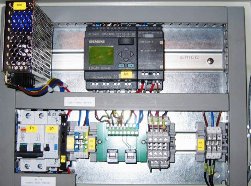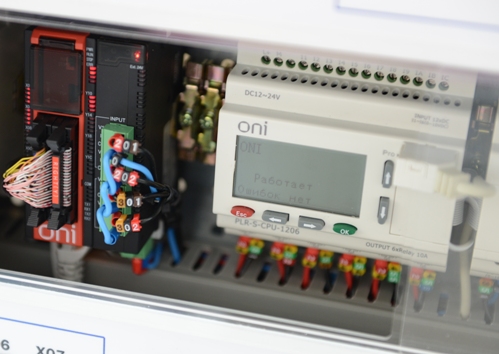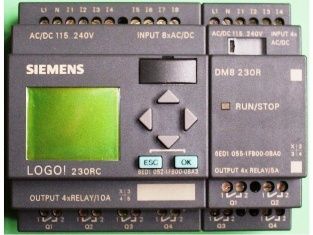Categories: Home automation, Programmable controllers
Number of views: 49218
Comments on the article: 4
Programmable Logic Controllers for Home Automation
 Programmable Logic Controllers (PLCs) - a magical combination of terms for the uninitiated and everyday reality for professionals. This material is for those who are simply interested in the possibility of using them for home automation.
Programmable Logic Controllers (PLCs) - a magical combination of terms for the uninitiated and everyday reality for professionals. This material is for those who are simply interested in the possibility of using them for home automation.
Let's start over, or from the “stove”. In not so distant times, electrical engineers designed their equipment based on existing discrete devices manufactured by industry. These are relays, timers, engine control buttons and a small list of devices that were available in a power that had vanished into the past.
Several decades passed, and the practice of working with individual electrical components almost stopped - the market was filled with universal devices that can perform any control and monitoring functions - PLC. In order to understand the features and capabilities of programmable controllers, consider their classification.
Classification
Programmable controllers there are universal and specialized. Specialized controllers include products oriented, for example, to compensate for the flow of reactive electric energy.
The number of input signals and their purpose are determined by the "firmware" of the controller memory and its circuit. The reaction is determined by the control logic and the number of output executive signals. Examples of such products are DCRK controllers of the Italian company Lovato Electric or reactive power controllers of the NOVAR series of the Czech company ZEZ Silko.
An even greater specialization of microprocessor controllers is observed in “Smart” controllers for controlling asynchronous motors: there all the functions of monitoring, control, response to emergency situations are concentrated in a simple chip that gives executive signals to the power elements of the circuit.
In contrast to specialized programmable controllers, universal PLC can be used to solve a diverse range of management and control tasks. Typically, when describing controllers, pay attention to programmability, the ability to replace any of the discrete devices. All this is fair. But the main advantage of the PLC is the ability to perform logical operations associated with conditional transitions in the control algorithm of external devices.
Appointment
At one time, for these purposes, the industry of the Soviet Union produced a series of modules "Logic-T" and "Logic-I". Those who were involved in the design or operation of the equipment in which they were used remember the cabinets tightly packed with modules and the bundles of wires connecting them.
In modern PLCs, all this is implemented in one housing in the form of software logic blocks, the number of which can reach several hundred. Therefore, the PLC primarily replaces the entire series of old modules, while performing many of the functions of executive external devices.
Application of programmable logic controllers (PLCs) in home automation systems
But in technology, you have to pay for everything. The universality of the controllers requires the redundancy of the capabilities inherent in them, because it is impossible to predict in advance which of the functions the consumer will require. Attempts to use the capabilities of a separate controller "to the maximum" leads to the need to purchase expansion modules, additional power supplies, communication modules, etc. Such systems are cumbersome and expensive.
The use of PLCs in the simplest control schemes is unjustified due to their high cost. What is the point of using a PLC as a normal intermediate relay or time relay? Although some experts say that with the number of switching devices more than two, it is already advisable to use a controller. But here it is necessary to understand: if there is no need for logical processing of signals, then there is no sense in "shooting from a gun at sparrows."
Keep in mind that even the simplest and popular PLCsuch as series LOGO from Siemens, Zelio Logic from Schneider Electric or family Rockwell Pico designed and manufactured for industrial use. With very high reliability, they are focused on solving the most simple automation tasks, ideally to control individual electrical installations. At the same time, certain knowledge is required, both in programming and installation.

Zelio Logic Schneider Electric PLC
PLC LOGO Siemens

PLC ARIES
PLC programming
For PLC programming, standardized languages of IEC (IEC) standard IEC61131-3 are used: LD (Ladder Diagram) - Relay circuit language, FBD (Function Block Diagram) - Function Block Language, SFC (Sequential Function Chart) - State Chart Language, IL (Instruction List) - Assembler-like language, ST (Structured Text) - Pascal-like language.

PLC for home automation
Recently there have been sets of smart devices designed exclusively for home automation. Possessing, possibly, less reliability in comparison with PLC, they are more focused on solving the problems of controlling home electrical appliances and are easy to install.
Therefore, deciding to do automation of home devices based on one of the PLC series, you need to be prepared to solve the problem of laying communication lines at home. You will need to purchase sensors with standard output signals that are compatible with controllers and master one of the programming languages in which you can "explain" to the universal controller what you want from it. If these tasks are not scary, then successful creativity!
See also at bgv.electricianexp.com
:


